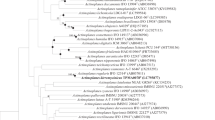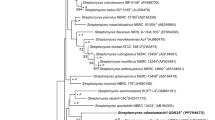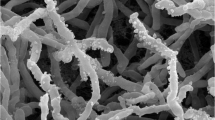Abstract
The motile actinomycete strain RI50-RCA114T was isolated using rehydration and centrifugation method from a soil sample obtained from Rishiri Island in Japan. The taxonomic status of this organism was established using a polyphasic approach. Cells of strain RI50-RCA114T were Gram positive, aerobic, motile and formed irregular sporangia. The strain grew in the presence of 0–2% (w/v) NaCl, between pH 5 and 8, and over a temperature range of 20–37°C, with optimal growth at 30°C. Whole-cell hydrolysates of the strain contained meso-diaminopimelic acid, galactose, glucose and mannose, in addition to one unidentified O-methyl-hexose. The predominant menaquinone was MK-9(H4), and the major polar lipids comprised phosphatidylethanolamine, diphosphatidylglycerol and phosphatidyl-N-methylethylethanolamine. The major cellular fatty acids were iso-C16:0, iso-C15:0 and anteiso-C17:0. Comparative 16S ribosomal RNA gene sequence analysis revealed that strain RI50-RCA114T had the closest sequence similarity with Actinoplanes globisporus JCM 3186T (97.6%). However, DNA–DNA hybridization assays as well as physiological and biochemical analyses differentiated strain RI50-RCA114T from its closest phylogenetic relative. On the basis of these data, we propose that strain RI50-RCA114T (=NBRC 108556T=BCC 49184T) be classified as the type strain of a novel Actinoplanes species and named Actinoplanes rishiriensis sp. nov.
Similar content being viewed by others
Log in or create a free account to read this content
Gain free access to this article, as well as selected content from this journal and more on nature.com
or
Accession codes
References
Goodfellow, M., Stanton, L. J., Simpson, K. E. & Minnikin, D. E. Numerical and chemical classification of Actinoplanes and some related actinomycetes. J. Gen. Microbiol. 136, 19–36 (1990).
Couch, J. N. Actinoplanes, a new genus of the Actinomycetales. J. Elisha Mitchell Sci. Soc. 66, 87–92 (1950).
Stackebrandt, E. & Kroppenstedt, R. M. Union of the genera Actinoplanes Couch, Ampullariella Couch, and Amorphosporangium Couch in a redefined genus Actinoplanes. Syst. Appl. Microbiol. 9, 110–114 (1987).
Krassil’nikov, N. A. Ray fungi and related organisms, Actinomycetales (Izdatel'stvo Akademii Nauk SSSR, Moscow, 1938).
Zhi, X. Y., Li, W. J. & Stackebrandt, E. An update of the structure and 16S rRNA gene sequence-based definition of higher ranks of the class Actinobacteria, with the proposal of two new suborders and four new families and emended descriptions of the existing higher taxa. Int. J. Syst. Evol. Microbiol. 59, 589–608 (2009).
Vobis, G. The genus Actinoplanes and related genera in The Prokaryotes: a Handbook on the Biology of Bacteria 3rd edn, Vol. 3 (eds Dworkin, M. Falkow, S. Rosenberg, E. Schleifer, K. H. & Stackebrandt, E.) 623–653 (Springer, New York, 2006).
Hayakawa, M. Studies on the isolation and distribution of rare actinomycetes in soil. Actinomycetologica 22, 12–19 (2008).
Hayakawa, M., Otoguro, M., Takeuchi, T., Yamazaki, T. & Iimura, Y. Application of a method incorporating differential centrifugation for selective isolation of motile actinomycetes in soil and plant litter. Antonie Van Leeuwenhoek 78, 171–185 (2000).
Ara, I., Yamamura, H., Tsetseg, B., Daram, D. & Ando, K. Actinoplanes toevensis sp. nov. and Actinoplanes tereljensis sp. nov., isolated from Mongolian soil. Int. J. Syst. Evol. Microbiol. 60, 919–927 (2010).
Ara, I., Yamamura, H., Tsetseg, B., Daram, D. & Ando, K. Luteipulveratus mongoliensis gen. nov., sp. nov., an actinobacterial taxon in the family Dermacoccaceae. Int. J. Syst. Evol. Microbiol. 60, 574–579 (2010).
Parenti, F., Beretta, G., Berti, M. & Arioli, V. Teichomycins, new antibiotics from Actinoplanes teichomyceticus nov. sp. I. Description of the producer strain, fermentation studies and biological properties. J. Antibiot. 31, 276–283 (1978).
Coronelli, C., Pagani, H., Bardone, M. R. & Lancini, G. C. Purpuromycin, a new antibiotic isolated from Actinoplanes ianthinogenes nov. sp. J. Antibiot. 27, 161–168 (1974).
Torikata, A. et al. Mycoplanecins, novel antimycobacterial antibiotics from Actinoplanes awajinensis subsp. mycoplanecinus subsp. nov. I. Taxonomy of producing organism and fermentation. J. Antibiot. 36, 957–960 (1983).
Parenti, F., Pagani, H. & Beretta, G. Lipiarmycin, a new antibiotic from Actinoplanes. I. Description of the producer strain and fermentation studies. J. Antibiot. 28, 247–252 (1975).
Amore, R. & Hollenberg, C. P. Xylose isomerase from Actinoplanes missouriensis: primary structure of the gene and protein. Nucleic Acids Res. 17, 7515 (1989).
Gong, C. S., Chen, L. F. & George, T. Purification and properties of glucose isomerase of Actinoplanes missouriensis. Biotechnol. Bioeng. 22, 833–845 (1980).
Chun, J. et al. EzTaxon: a web-based tool for the identification of prokaryotes based on 16S ribosomal RNA gene sequences. Int. J. Syst. Evol. Microbiol. 57, 2259–2261 (2007).
Tamura, T., Ishida, Y. & Suzuki, K.-I. Descriptions of Actinoplanes ianthinogenes nom. rev. and Actinoplanes octamycinicus corrig. comb. nov., nom. rev. Int. J. Syst. Evol. Microbiol. 61, 2916–2921 (2011).
Lechevalier, M. P., De Bivre, C. & Lechevalier, H. A. Chemotaxonomy of aerobic actinomycetes: phospholipid composition. Biochem. Syst. Ecol. 5, 249–260 (1977).
Wayne, L. G. et al. Report of the ad hoc committee on reconciliation of approaches to bacterial systematics. Int. J. Syst. Bacteriol. 37, 463–464 (1987).
Hayakawa, M. & Nonomura, H. Humic acid-vitamin agar, a new medium for the selective isolation of soil actinomycetes. J. Ferment. Technol. 65, 501–509 (1987).
Hayakawa, M., Iino, S. & Nonomura, H. Heavy metal resistance and melanoid pigment production in the streptomycete flora of copper-polluted vineyard soils. J. Ferment. Technol. 60, 1–9 (1982).
Nonomura, H., Iino, S. & Hayakawa, M. Classification of actinomycete genus Ampullariella from soils of Japan. J. Ferment. Technol. 57, 79–85 (1979).
Gerhardt, P. Manual of Methods for General Bacteriology (American Society for Microbiology, Washington, DC, 1981).
Jones, K. L. Fresh isolates of actinomycetes in which the presence of sporogenous aerial mycelia is a fluctuating characteristic. J. Bacteriol. 57, 141–145 (1949).
Shirling, E. B. & Gottlieb, D. Methods for characterization of Streptomyces species. Int. J. Syst. Bacteriol. 16, 313–340 (1966).
Gordon, R. E. & Mihm, J. M. Identification of Nocardia caviae (Erikson) nov. comb. Ann. NY. Acad. Sci. 98, 628–636 (1962).
Hasegawa, T., Takizawa, M. & Tanida, S. A rapid analysis for chemical grouping of aerobic actinomycetes. J. Gen. Appl. Microbiol. 29, 319–322 (1983).
Sasser, M. Identification of Bacteria by Gas Chromatography of Cellular Fatty Acids. (Microbial ID Inc., Newark, DE, 1990).
Minnikin, D. E. et al. An integrated procedure for the extraction of bacterial isoprenoid quinines and polar lipids. J. Microbiol. Methods 2, 233–241 (1984).
Hamada, M. et al. Mobilicoccus pelagius gen. nov., sp. nov. and Piscicoccus intestinalis gen. nov., sp. nov., two new members of the family Dermatophilaceae, and reclassification of Dermatophilus chelonae (Masters et al. 1995) as Austwickia chelonae gen. nov., comb. nov. J. Gen. Appl. Microbiol. 56, 427–436 (2010).
Yassin, A. F., Haggenei, B., Budzikiewicz, H. & Schaal, K. P. Fatty acid and polar lipid composition of the genus Amycolatopsis: application of fast atom bombardment-mass spectrometry to structure analysis of underivatized phospholipids. Int. J. Syst. Bacteriol. 43, 414–420 (1993).
Tamaoka, J. & Komagata, K. Determination of DNA base composition by reversed-phase high-performance liquid chromatography. FEMS Microbiol. Lett. 25, 125–128 (1984).
Saito, H. & Miura, K.-I. Preparation of transforming deoxyribonucleic acid by phenol treatment. Biochim. Biophys. Acta. 72, 619–629 (1963).
Hatano, K., Nishii, T. & Kasai, H. Taxonomic re-evaluation of whorl-forming Streptomyces (formerly Streptoverticillium) species by using phenotypes, DNA–DNA hybridization and sequences of gyrB, and proposal of Streptomyces luteireticuli (ex Katoh and Arai 1957) corrig., sp. nov., nom. rev. Int. J. Syst. Evol. Microbiol. 53, 1519–1529 (2003).
Tamura, T. & Hatano, K. Phylogenetic analysis of the genus Actinoplanes and transfer of Actinoplanes minutisporangius Ruan et al. 1986 and ‘Actinoplanes aurantiacus’ to Cryptosporangium minutisporangium comb. nov. and Cryptosporangium aurantiacum sp. nov. Int. J. Syst. Evol. Microbiol. 51, 2119–2125 (2001).
Thompson, J. D., Gibson, T. J., Plewniak, F., Jeanmougin, F. & Higgins, D. G. The CLUSTAL_X Windows interface: flexible strategies for multiple sequence alignment aided by quality analysis tools. Nucleic Acids Res. 25, 4876–4882 (1997).
Tamura, K. et al. MEGA5: Molecular evolutionary genetics analysis using maximum likelihood, evolutionary distance, and maximum parsimony methods. Mol. Biol. Evol. 28, 2731–2739 (2011).
Saitou, N. & Nei, M. The neighbor-joining method: a new method for reconstructing phylogenetic trees. Mol. Biol. Evol. 4, 406–425 (1987).
Takahashi, K. & Nei, M. Efficiencies of fast algorithms of phylogenetic inference under the criteria of maximum parsimony, minimum evolution, and maximum likelihood when a large number of sequences are used. Mol. Biol. Evol. 17, 1251–1258 (2000).
Felsenstein, J. Confidence limits on phylogenies: an approach using the bootstrap. Evolution 39, 783–791 (1985).
Kusunoki, S. et al. Application of calorimetric microdilution plate hybridization for rapid generic identification of 22 Mycobacterium species. J. Clin. Microbiol. 29, 1596–1603 (1991).
Acknowledgements
This study was supported in part by a research grant from the Institute for Fermentation, Osaka (IFO), Japan. We are grateful to Dr Jean P Euzéby for support with nomenclature.
Author information
Authors and Affiliations
Corresponding author
Additional information
Supplementary Information accompanies the paper on The Journal of Antibiotics website
Supplementary information
Rights and permissions
About this article
Cite this article
Yamamura, H., Shimizu, A., Nakagawa, Y. et al. Actinoplanes rishiriensis sp. nov., a novel motile actinomycete isolated by rehydration and centrifugation method. J Antibiot 65, 249–253 (2012). https://doi.org/10.1038/ja.2012.8
Received:
Revised:
Accepted:
Published:
Issue date:
DOI: https://doi.org/10.1038/ja.2012.8
Keywords
This article is cited by
-
Associations between species-level indoor microbiome, environmental characteristics, and asthma in junior high schools of Terengganu, Malaysia
Air Quality, Atmosphere & Health (2022)
-
Actinoplanes solisilvae sp. nov., Isolated from Birch Forest Soil
Current Microbiology (2020)



